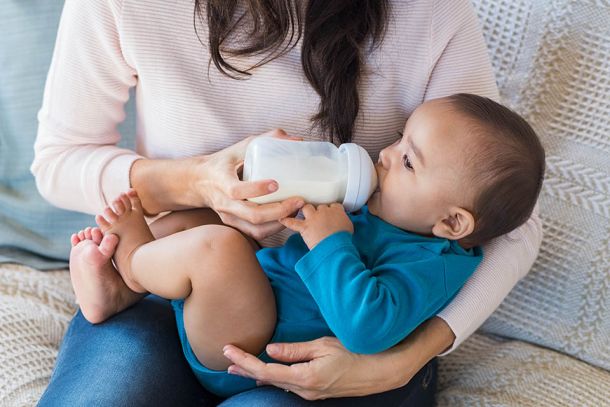Properly sterilize all equipment!

If you choose to bottle feed your baby you can (like breastfeeding mothers) feed on demand. Simply watch your baby for signs that he is hungry. This could include: sucking on his finger or fist, licking or smacking his lips, or seaching with an open mouth. Crying is often one of the last signs that your baby is hungry. Your baby will also let you know when he has had enough to eat, for example, he might slow or stop his sucking, let go of the bottle and turn his head away, or seal his lips. If you see signs that your baby is full, stop feeding. If you ignore these signs, your baby may cry, bite the nipple, cover his mouth, arch his back, kick or become fussy.
Babies’ immune systems are not fully developed and they are especially vulnerable to food borne illness. When bottle feeding, you must ensure all your equipment is properly sterilized and the formula is prepared with boiled water. Use these following steps to keep your baby healthy or print this handy diagram and tips for feeding formula and carry it with you!
How to Sterilize Baby Bottles
You will need:
- Large pot with a lid
- Bottle brush and nipple brush
- Tongs, knife, fork, can opener, glass measuring cup
- Bottles (preferably glass) nipples, caps, rims
- If using disposable bottles, you will also need a roll of disposable liners
Steps
- Wash hands and counter with soap and water.
- Wash all items in warm soapy water.
- Make sure holes in nipples are not clogged.
- Rinse well.
- Put clean items in a pot, fill with water.
- If using dispoable bottles, sterilize only nipples and caps.
- Boil for 2 minutes, keep pot covered until items are needed.
- Remove items with tongs, set on a clean paper towel.
How to prepare baby formula
Babies who are less than 2 months old, are pre-term, have weak immune systems or low birth weight should not be fed powdered infant formula as it is not sterile. These babies should use ready-to-feed or liquid concentrate formula which are both sterile. Until your baby is 4 months old, boil all water for 2 minutes before you prepare the formula - even bottled water, it's not sterile! If you are using well water, it should be tested 4 times a year (every season) for bacteria that may be harmful for your baby. Testing can be done at Public Health Offices.
- DO NOT use an electric kettle as the water may not boil for 2 minutes before it switches off.
- DO NOT use a microwave as it may not boil the water evenly.
Steps
- Wash hands and counter with soap and water.
- Run cold water for at least 2 minutes (use approved filter if you have lead pipes). Boil water for two minutes. Let cool and use within 30 minutes.
- Have sterilized equipment ready on a clean paper towel. Wash the top of the formula can with warm water.
- Pour boiled water in an empty measuring cup.
- Fill scoop from can with powder, level with a knife.
- According to the directions on the label, add the required number of scoops of powder to the boiled water. Mix until no lumps of powder are left.
- Pour amount of infant formula for one feeding into each bottle (use glass if possible).
- Pick up nipples, rims and caps with sterile tongs and put on bottles. Tighten with your hands.
- Shake bottle well. Cool bottle under cold running water.
- Put bottles in refrigerator. Use within 24 hours.
- Cover can with plastic lid. Store in a cool, dry place. Use within 1 month.
How to feed with a bottle
- Before feeding your baby, place the bottle of formula in warm water for up to 15 minutes, shaking the bottle so it will heat evenly. Do not heat bottles on the stove or in the moicrowave. The microwave creates hot spots which could burn your baby's mouth.
- Test the temperature of the formula by putting a few drops on your wrist, it should be between room and body temperature (21C-37C).
- Watch your baby for early feeding cues and wait for her to open her mouth.
- Tip the bottle slightly so there is no air in the nipple. Always hold your baby in an upright position.
- Watch your baby swallow and allow him to rest. Burp baby as needed. Stop feeding when he shows signs of being full.
- Throw away what your baby doesn't drink within one hour. Rinse out bottle and nipple.
Storage
Once a bottle of formula has been prepared, bacteria can grow in the formula and make your baby sick. Keep your baby's formula safe by following these steps:
- Throw away any leftover formula that is not used within 2 hours of starting to feed.
- Use prepared bottles stored in the fridge within 24 hours.
- Do not freeze any kind of infant formula. Freezing changes the fat in the formula.
- Rinse bottle and nipples right away after use.
- If you find you are wasting a lot of formula, try preparing smaller bottles.
How much formula to feed your baby
| Age | Number of Feedings in 24hours | Approx. amount of formula per bottle (30ml = 1oz) |
|---|---|---|
| birth-2 weeks | 6-10 | 60-90ml (2-3oz) |
| 2 weeks-1 month | 6-10 | 90-120ml (3-4oz) |
| 1-2 months | 6-8 | 120-180ml (4-6oz) |
| 2-6 months | 5-7 | 180-210ml (6-7oz) |
| 6-9 months | 4-5 | 210-240ml (7-8oz) |
| 9-12 months | 3-4 | 210-240ml (7-8oz) |
| 12 months+ | 3 or less | 210-240ml (7-8oz) |
References:
Feeding Your Baby Infant Formula Kingston Public Health
How To Feed Your Baby With A Bottle Toronto Public Health, September 2010.
